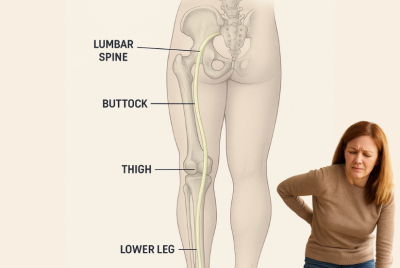Is Walking Good for Sciatica Pain?
A Comprehensive Guide to Moving Without Aggravation
Sciatica is a common condition affecting millions worldwide, characterized by pain radiating along the sciatic nerve, from the lower back down the leg. If you’re suffering from sciatica, you’re likely searching for safe and effective ways to ease the discomfort without making it worse. One of the most frequently asked questions is: Is walking good for sciatica pain?
The short answer: Yes—if done correctly. In this comprehensive guide, we’ll explore how walking impacts sciatica, the potential benefits, mistakes to avoid, and practical tips for incorporating it into your recovery plan.
Understanding Sciatica and Its Causes
Before exploring the benefits of walking, it’s essential to understand what sciatica is. Sciatica is not a medical condition in itself, but a symptom of underlying issues like:
- Herniated discs
- Spinal stenosis
- Piriformis syndrome
- Degenerative disc disease
These conditions cause compression or irritation of the sciatic nerve, leading to pain, numbness, or tingling in the lower body.
Can Walking Help Relieve Sciatica Pain?
The Benefits of Walking
When done mindfully, walking can:
- Promote blood circulation to the lower back and legs, speeding up healing.
- Improve posture, which reduces pressure on the sciatic nerve.
- Strengthen lower back and core muscles, supporting spinal alignment.
- Trigger endorphin release, which helps reduce pain perception naturally.
How Walking Compares to Other Forms of Exercise
Low-impact and accessible, walking is often more tolerable than high-intensity activities or prolonged sitting, which may worsen symptoms.
Evidence-Based Support
Multiple studies suggest that regular, gentle walking can reduce lower back and sciatic pain when paired with stretching and strengthening exercises.
Mistakes to Avoid When Walking with Sciatica
Walking can offer relief, but not if done incorrectly. Common mistakes include:
1. Walking with Poor Posture
Leaning forward or slouching puts extra stress on the lower back. Maintain a neutral spine and engage your core.
2. Overstriding
Taking steps that are too long can increase impact and strain the lower back. Keep your stride natural.
3. Wearing the Wrong Shoes
Footwear without proper arch support or cushioning can worsen symptoms. Invest in quality walking shoes.
4. Ignoring Pain Signals
If your pain worsens during or after walking, it’s a sign to slow down or consult a specialist.
Tips for Walking Safely with Sciatica
To get the most out of your walks, follow these tips:
1. Warm Up First
Begin with 5–10 minutes of gentle stretching targeting the hamstrings, hip flexors, calves, and lower back. This increases flexibility and prepares the muscles for movement, reducing the risk of strain.
2. Start Small
Start with short walks—5 to 10 minutes at a comfortable pace. Monitor how your body responds and gradually increase your walking time and distance as tolerated.
3. Walk on Even Surfaces
Choose smooth, flat surfaces such as sidewalks, indoor tracks, or treadmills. Avoid trails or uneven paths that may cause instability or worsen sciatic pain.
4. Engage Your Core
Lightly activate your abdominal muscles while walking to help support your spine. This reduces the load on your lower back and may help ease pressure on the sciatic nerve.
5. Use Walking Aids if Needed
If you struggle with balance or leg weakness, a cane or walking stick can reduce stress on the lower body and help prevent falls. Use it on the opposite side of your painful leg.
6. Focus on Your Gait
Walk with smooth, steady steps. Keep your shoulders relaxed and avoid limping or favoring one side, which can cause muscle imbalances.
7. Stay Hydrated and Take Breaks
Dehydrated muscles are more prone to tightness and cramping. Drink water before and after your walk. If pain begins during your walk, rest and resume only if it subsides.
8. Wear a Supportive Brace (Optional)
Some people find relief using a lumbar support belt during walks. This can help stabilize your lower back and minimize pain during activity.
Complementary Strategies to Enhance Relief
Walking alone may not be enough. Enhance your sciatica relief with:
- Stretching routines targeting the hamstrings, piriformis, and hip flexors
- Core strengthening to support the lumbar spine
- Cold and heat therapy to manage flare-ups
- Physical therapy for personalized treatment plans
When to Avoid Walking with Sciatica
In some cases, walking may aggravate pain. Stop walking and consult a healthcare provider if you experience:
- Sharp, shooting pain down your leg
- Muscle weakness or loss of control in the leg or foot
- Pain that worsens over time despite walking
When to See a Doctor
While walking can be a safe and effective way to manage mild to moderate sciatica, it’s essential to recognize when professional help is needed. You should see a doctor if:
- Your pain persists longer than a few weeks without improvement
- You experience sudden or severe leg pain, numbness, or weakness
- Your symptoms interfere significantly with daily activities or sleep
- You have trouble controlling your bladder or bowels (a possible sign of cauda equina syndrome)
- Walking or movement becomes increasingly difficult despite self-care
A healthcare provider can perform tests to identify the underlying cause of your sciatica and recommend appropriate treatments, including medications, physical therapy, or advanced interventions if needed.
FAQ Related to Is Walking Good for Sciatica Pain
Q1: Can walking too much worsen sciatica?
A: Yes, overdoing it can strain your back and legs. Stick to moderate, manageable walks and listen to your body.
Q2: How long should I walk with sciatica?
A: Start with 5–10 minutes per session, 1–2 times a day. Slowly increase based on how your body responds.
Q3: Should I walk uphill or on inclines?
A: It’s best to start on flat ground. Hills may increase back pressure unless advised otherwise by a professional.
Q4: What type of shoes are best for walking with sciatica?
A: Choose shoes with good arch support, cushioning, and a stable sole. Avoid flip-flops or unsupportive sneakers.
Q5: Can walking prevent future sciatica flare-ups?
A: Yes, regular walking improves spinal health, strengthens supporting muscles, and enhances posture—reducing the risk of future episodes.
Final Thoughts: Keep Moving—Smartly
So, is walking good for sciatica pain? Absolutely—but only when done with care and awareness. It can be a powerful tool in your recovery, promoting healing and reducing discomfort.
If you’re unsure where to start, consider speaking with a physical therapist or healthcare provider. Walking, when combined with proper posture, supportive footwear, and complementary treatments, can help you regain mobility and get back to living pain-free.
Disclaimer
This article is for informational purposes only and is not intended to substitute professional medical advice, diagnosis, or treatment. Always consult your physician or other qualified healthcare provider with any questions you may have regarding a medical condition. Never disregard professional medical advice or delay in seeking it because of something you have read on SciaticaPainGuide.com.
Related Articles:
- 7 Gentle Sciatica Stretches You Can Do at Home
- Cold Therapy for Sciatica: Does It Work?
- The Best Shoes for Sciatica Relief





